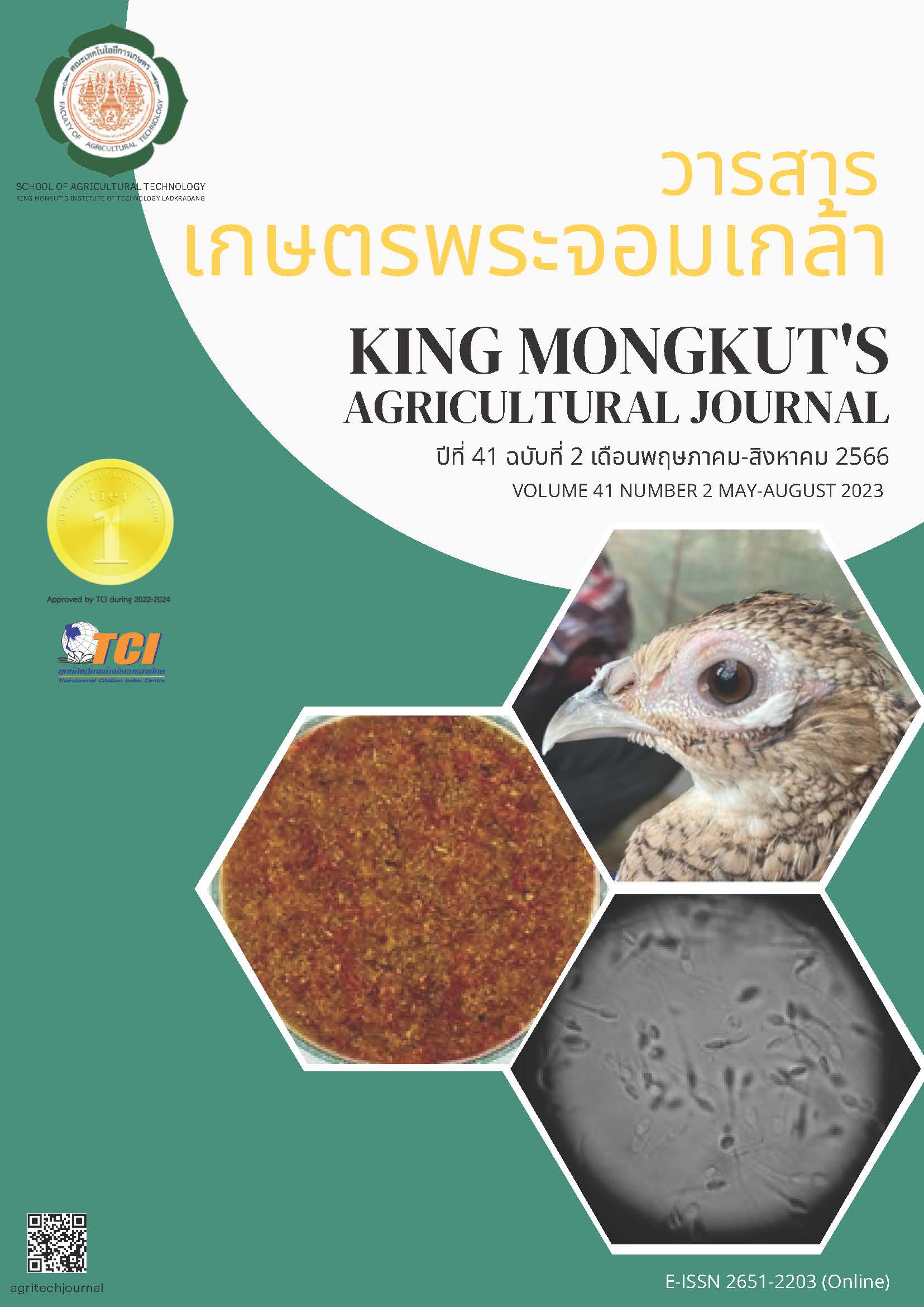การศึกษาเบื้องต้นถึงประสิทธิภาพของกรดอินทรีย์ 4 ชนิดในการต้านเชื้อแบคทีเรีย ก่อโรคเต้านมอักเสบในโคนม
Main Article Content
บทคัดย่อ
การศึกษานี้มีวัตถุประสงค์เพื่อศึกษาถึงประสิทธิภาพในการฆ่าเชื้อของกรดฟอร์มิก กรดแลกติก กรดมาลิก และกรดซิตริกต่อเชื้อก่อโรคเต้านมอักเสบในโคนม ซึ่งเชื้อที่สำคัญ ได้แก่ Klebsiella spp, Escherichia coli, Streptococcus dysgalactiae, Streptococcus uberis และ Staphylococcus aureus ทางห้องปฏิบัติการและการทดสอบบนตัวสัตว์ โดยประเมินจากค่าความเข้มข้นต่ำสุดที่สามารถฆ่าเชื้อแบคทีเรีย (Minimum bactericidal concentration; MBC) และการลดลงของจำนวนเชื้อที่หัวนมภายหลังการใช้สารละลายกรดดังกล่าว พบว่า กรดฟอร์มิกมีประสิทธิภาพในการฆ่าเชื้อก่อโรคได้ดีที่สุด โดยมีค่า MBC เท่ากับ 0.191% v/v ต่อทุกเชื้อก่อโรค รองลงมาได้แก่ กรดแลกติก 10.625% กรดมาลิก 12.37% และกรดซิตริก 12.43% ตามลำดับ เมื่อนำสารละลายที่เตรียมตามความเข้มข้นข้างต้น ใช้พ่นฆ่าเชื้อที่หัวนมโคแล้วประเมินประสิทธิภาพจากปริมาณของเชื้อก่อโรคที่ลดลง พบว่า กรดซิตริก 12.43% มีประสิทธิภาพดีที่สุด คือ สามารถลดเชื้อลงได้ 1.15 log10 CFU/ml (P<0.05) เช่นเดียวกับกรดแลกติกที่สามารถลดเชื้อได้ 1.69 log10 CFU/ml (P=0.32) ในขณะที่กรดฟอร์มิก และกรดมาลิกไม่สามารถลดปริมาณของเชื้อก่อโรคได้ ต่ำกว่ากลุ่มควบคุม ผลการศึกษานี้แสดงให้เห็นว่ากรดซิตริก และกรดแลกติกมีประสิทธิภาพเหมาะสมในการฆ่าเชื้อที่ก่อให้เกิดโรคเต้านมอักเสบในโคได้
Article Details

อนุญาตภายใต้เงื่อนไข Creative Commons Attribution-NonCommercial-NoDerivatives 4.0 International License.
วารสารเกษตรพระจอมเกล้า
เอกสารอ้างอิง
Boddie, R. L. & Nickerson, S. C. (1988). Efficacy of a Fatty Acid-Lactic Acid Postmilking Teat Germicide in Reducing Incidence of Bovine Mastitis. Journal of Food Protection. 51(10), 799-801.
Boonyayatra, S. & Chaisri, W. (2004). Incidence and prevalence of subclinical mastitis in small holder dairy farm in Chiang mai province, Thailand. Chiang Mai Veterinary medicine Journal. 2, 25-30. (in Thai).
Cha, C. N., Park, E. K., Jung, J. Y., Yoo, C. Y., Kim, S. & Lee, H. J. (2016). Bactericidal Efficacy of a disinfectant spray containing a grapefruit-seed extract, citric acid, malic acid and benzalkonium chloride against Salmonella Typhimurium and Brucella ovis. Journal of Food Hygiene and Safety. 31(4), 299-303.
Clinical and Laboratory Standards Institute. (2017). Performance standards for antimicrobial susceptibility testing; twenty three informatinal supplement. CLSI document M100-S23. Pensylvania: Clinical and Laboratory Standards Institute.
Eardmusic, S. & Yodmingkwan, P. (2016). Microbiology quality of raw milk in bulk tanks from dairy farms at Cha-am district, Phetchaburi province. Khon Kaen agriculture journal. 44 (suppl 1), 487-493. (in Thai).
Jarassaeng, C., Aiumlamai, S., Wachirapakorn, C., Techakumphu, M., Noordhuizen, J. P. T. M., Beynen & A. C. Suadsong. S. (2012). Risk factors of subclinical mastitis in small holder dairy cows in Khon kaen province. The Thai Journal of Veterinary Medicine. 42(2), 143-151. (in Thai).
Kampa, J., Sukolapong, V., Chaiyotwittakun, A., Rerk-u-suke, A. & Polpakdee, A. (2010). Chronic mastitis in small dairy cattle herds in Muang Khon Kaen. The Thai Journal of Veterinary Medicine. 40(3), 265-272. (in Thai).
Mišeikiene, R., Rudejeviene, J. & Gerulis, G. (2015). Effect of pre-milking antiseptic treatment on the bacterial contamination of cow teats’ skin. Bulgarian Journal of Veterinary Medicine. 18(2), 159-166.
Pavicic, Ž., Cergolj, M., Balenovic, T., Ekert-Kabalin, A. & Valpotic, H. (2008). Influence of udder sanitation on hygienic quality of cow milk. Veterinarski Arhiv. 78, 105-112.
Panyapinyopol, B., Marhaba, T. F., Kanokkantapong, V. & Pavasant. P. (2005). Characterization of precursors to trihalomethanes formation in Bangkok source water. Journal of Hazardous Materials. 120, 229-236. (in Thai).
Rodrigues, P. M. S. M., Esteves da Silva, J. C. G. & Antunes, M. C. G. (2007). Factorial analysis of the trihalomethanes formation in water disinfection using chlorine. Analytica Chimica Acta. 595, 266-274.
Ruegg, P. L. & Dohoo, I. R. (1997). A benefit to cost analysis of the effect of premilking teat hygiene on somatic cell count and intramammary infections in a commercial dairy herd. Canadian Veterinary Journal. 38, 632-636.
Seo Y., Lee, G., Song, S., Kim, K. & Cho, M. (2021). Combinatorial treatment using citric acid, malic acid, and phytic acid for synergistical inactivation of foodborne pathogenic bacteria. Korean J Chem Eng. 38, 826-832.
Soccol, C. R., Vandenberghe, L. P. S., Rodrigues, C. & Pandey, A. (2006). New perspectives for citric acid production and application. Food Technoogy Biotechnology. 44(2), 141-149.
Suriyasathaporn, W. & Chupia, V. (2011). Reduction in numbers of bacteria after pre-milking teat dipping in milking dairy cows. Chiang Mai University Journal of Natural Sciences. 10(2), 301-306. (in Thai).
The National Mastitis Council. (2016). Recommended Mastitis Control Program. The National Mastitis Council. Retrieved from: https://www.nmconline.Org/Docs/NMCchecklistNA.Pdf
Vargas, C. (2017). Organic acids: characteristics, properties and synthesis. New York: Nova Science Publishers, Inc.


